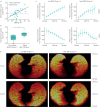Proning reduces ventilation heterogeneity in patients with elevated BMI: implications for COVID-19 pneumonia management?
- PMID: 32685437
- PMCID: PMC7357272
- DOI: 10.1183/23120541.00292-2020
Proning reduces ventilation heterogeneity in patients with elevated BMI: implications for COVID-19 pneumonia management?
Abstract
Simulations of patient-based lungs suggest that proning reduces ventilation heterogeneity in overweight and obese subjects but increases heterogeneity in non-overweight subjects. This suggests proning may be beneficial for overweight #COVID19 patients. https://bit.ly/2MfCiyk.
Copyright ©ERS 2020.
Conflict of interest statement
Conflict of interest: B.H. Foy has nothing to disclose. Conflict of interest: C.E. Brightling has nothing to disclose. Conflict of interest: S. Siddiqui has nothing to disclose.
Figures

References
-
- The OpenSAFELY Collaborative , Williamson E, Walker AJ, et al. . OpenSAFELY: factors associated with COVID-19-related hospital death in the linked electronic health records of 17 million adult NHS patients. MedRxiv 2020; preprint [DOI: 10.1101/2020.05.06.20092999].
LinkOut - more resources
Full Text Sources
